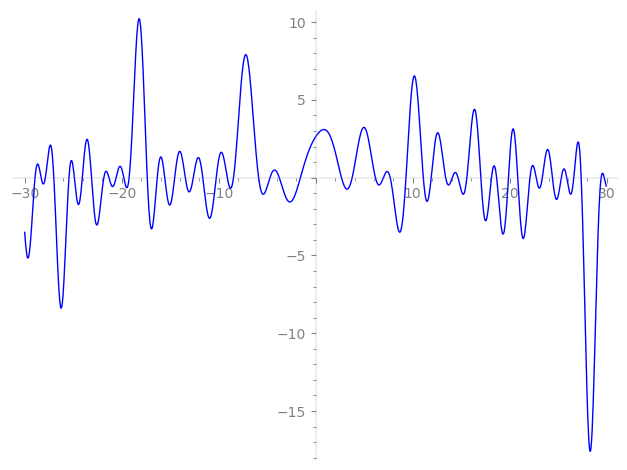| L(s) = 1 | + (2.16 − 1.81i)2-s + (3.06 + 4.19i)3-s + (1.40 − 7.87i)4-s − 20.4i·5-s + (14.2 + 3.52i)6-s + 7i·7-s + (−11.2 − 19.6i)8-s + (−8.20 + 25.7i)9-s + (−37.1 − 44.3i)10-s + 32.3·11-s + (37.3 − 18.2i)12-s + 24.7·13-s + (12.7 + 15.1i)14-s + (85.8 − 62.7i)15-s + (−60.0 − 22.0i)16-s + 103. i·17-s + ⋯ |
| L(s) = 1 | + (0.766 − 0.642i)2-s + (0.590 + 0.807i)3-s + (0.175 − 0.984i)4-s − 1.83i·5-s + (0.970 + 0.240i)6-s + 0.377i·7-s + (−0.497 − 0.867i)8-s + (−0.303 + 0.952i)9-s + (−1.17 − 1.40i)10-s + 0.887·11-s + (0.898 − 0.439i)12-s + 0.527·13-s + (0.242 + 0.289i)14-s + (1.47 − 1.08i)15-s + (−0.938 − 0.344i)16-s + 1.48i·17-s + ⋯ |
Λ(s)=(=(84s/2ΓC(s)L(s)(0.439+0.898i)Λ(4−s)
Λ(s)=(=(84s/2ΓC(s+3/2)L(s)(0.439+0.898i)Λ(1−s)
| Degree: |
2 |
| Conductor: |
84
= 22⋅3⋅7
|
| Sign: |
0.439+0.898i
|
| Analytic conductor: |
4.95616 |
| Root analytic conductor: |
2.22624 |
| Motivic weight: |
3 |
| Rational: |
no |
| Arithmetic: |
yes |
| Character: |
χ84(71,⋅)
|
| Primitive: |
yes
|
| Self-dual: |
no
|
| Analytic rank: |
0
|
| Selberg data: |
(2, 84, ( :3/2), 0.439+0.898i)
|
Particular Values
| L(2) |
≈ |
2.23883−1.39713i |
| L(21) |
≈ |
2.23883−1.39713i |
| L(25) |
|
not available |
| L(1) |
|
not available |
L(s)=p∏Fp(p−s)−1 | p | Fp(T) |
|---|
| bad | 2 | 1+(−2.16+1.81i)T |
| 3 | 1+(−3.06−4.19i)T |
| 7 | 1−7iT |
| good | 5 | 1+20.4iT−125T2 |
| 11 | 1−32.3T+1.33e3T2 |
| 13 | 1−24.7T+2.19e3T2 |
| 17 | 1−103.iT−4.91e3T2 |
| 19 | 1−3.49iT−6.85e3T2 |
| 23 | 1−18.3T+1.21e4T2 |
| 29 | 1+146.iT−2.43e4T2 |
| 31 | 1−326.iT−2.97e4T2 |
| 37 | 1−37.6T+5.06e4T2 |
| 41 | 1−111.iT−6.89e4T2 |
| 43 | 1+119.iT−7.95e4T2 |
| 47 | 1−145.T+1.03e5T2 |
| 53 | 1+386.iT−1.48e5T2 |
| 59 | 1−108.T+2.05e5T2 |
| 61 | 1+305.T+2.26e5T2 |
| 67 | 1−508.iT−3.00e5T2 |
| 71 | 1−99.6T+3.57e5T2 |
| 73 | 1+478.T+3.89e5T2 |
| 79 | 1+887.iT−4.93e5T2 |
| 83 | 1−26.5T+5.71e5T2 |
| 89 | 1+807.iT−7.04e5T2 |
| 97 | 1−1.29e3T+9.12e5T2 |
| show more | |
| show less | |
L(s)=p∏ j=1∏2(1−αj,pp−s)−1
Imaginary part of the first few zeros on the critical line
−13.44480887679980154193289979563, −12.61920265279812531379522530719, −11.64108456147785031488594031772, −10.25630120297532286640451612346, −9.115899314668314946511547250674, −8.474346461177702836747746398756, −5.88476341596555632707010313845, −4.72026862935323924448425834079, −3.75717471232301240538865223635, −1.57716272302113645878034162113,
2.65553245235578808629773357056, 3.75635938897920182613074682828, 6.15326008540191995180315581846, 6.97580189231654458153925882662, 7.67615938197768359822455421518, 9.301540638230577911005136297101, 11.09021022851261240745937372107, 11.90174347636782443341628088639, 13.39452366176522346680257983742, 14.07524958977226603991603562014

